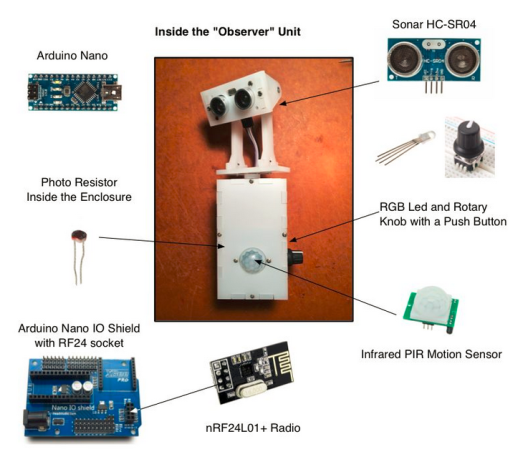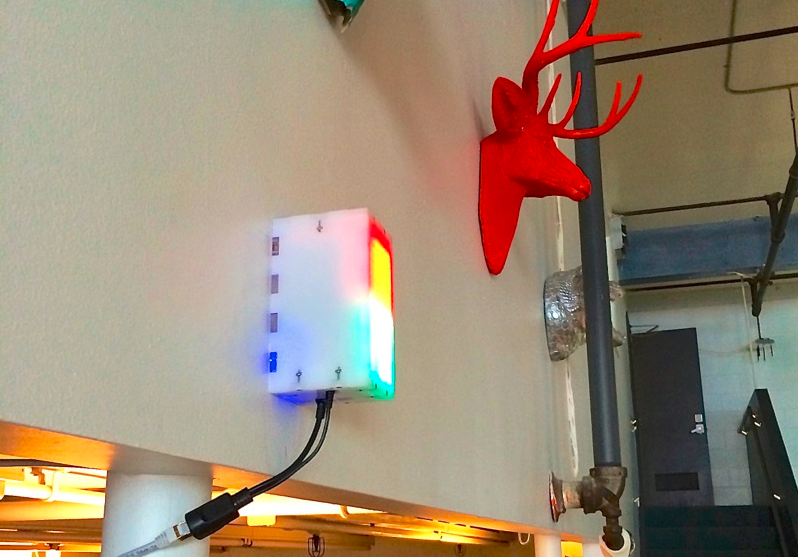A recent company move has left [kigster] and his 35 coworkers in a frustrating situation. Their new building only has two single occupancy bathrooms. To make matters worse, the bathrooms are located on two different floors. Heading to one bathroom, finding it occupied, then running upstairs to find the second bathroom also occupied became an all to common and frustrating occurrence at the office.
It was obvious the office needed some sort of bathroom occupancy monitoring system – much like those available on commercial aircraft. [kigster] asked for a budget of about $200 to build such a system. His request was quickly granted it by office management. They must have been on their way to the bathroom at the time.
 [kigster] began work on BORAT: Bathroom Occupancy Remote Awareness Technology. The initial problem was detecting bathroom occupancy. The easiest method would be to use door locks with embedded switches, much those used in aircraft. Unfortunately, modifying or changing the locks in a rented office space is a big no-no. Several other human detection systems were suggested and rejected. The final solution was a hybrid. Sonar, Passive Infrared (PIR), and light sensors work in concert to detect if a person is in the bathroom. While we think the final “observer unit” is rather cool looking, we’re sure unsuspecting visitors to the office may be wondering why a two eyed robot is staring at them on the throne.
[kigster] began work on BORAT: Bathroom Occupancy Remote Awareness Technology. The initial problem was detecting bathroom occupancy. The easiest method would be to use door locks with embedded switches, much those used in aircraft. Unfortunately, modifying or changing the locks in a rented office space is a big no-no. Several other human detection systems were suggested and rejected. The final solution was a hybrid. Sonar, Passive Infrared (PIR), and light sensors work in concert to detect if a person is in the bathroom. While we think the final “observer unit” is rather cool looking, we’re sure unsuspecting visitors to the office may be wondering why a two eyed robot is staring at them on the throne.
The display side of the system was easy. The entire system communicates with the venerable nRF24L01+ radio modules, so the display just needed a radio module, an arduino, and a way of displaying bathroom status. Two LED matrices took care of that issue.
We really like this hack. Not only is it a great use of technology to solve a common problem, but it’s also an open source system. BORAT’s source code is available on [kigster’s] github.
Want to know more about BORAT? Kigster is answering questions over on his thread in the Arduino subreddit.
















THAT’SA VERY NICE
Borat: If I work here, can I work in a room with a light?
Employer: Yeah. Everyone gets to work in a room with a light.
Borat: Great success!
http://i.imgur.com/8dZwHAy.jpg
That’s a hack!
I LOVE to sit on toilets where a contraption I dont understand, but looks like some sort of sensor/camera is mounted strait in front of me!
No seriously, it could have been a bit less in-your-face. Also, the ESP8266 would be a great addition so coworkers can visit the website isthepooperoccupied.com and see the currect status from their desktop/mobile.
Why not just a deadbolt on the inside of the door with a sensor that indicates when the deadbolt is closed (i.e. the toilet is occupied)? Like the Occupied/Unoccupied indicator that’s attached to the lock on an airline lavatory door.
They can’t modify the locks on a rented office.
The rented office has single bathrooms without lockable doors?
“Hey Landlord, why excactly do my bathroom has no locks again?”
“The Land of the Free”
There’s a lock, you just can’t modify it because it’s a rented office.
I know, right? Failing that, he should have used nRF24L01+ radio modules, an arduino, and two LED matrices for displaying bathroom status.
Also, cannot see ‘occupied’ sign from another floor.
“Unfortunately, modifying or changing the locks in a rented office space is a big no-no.”
Why do people treat rented space like a holy shrine? They have budget for a 35 person payroll but they’re worried if they modify a couple of interior doors the landlord will what – charge them a few hundred dollars to replace the door – or more probably just leave the modifications in place for the next tenant.
Considering that a lot of “next tenants” will gut the space and rebuild to their specifications.
This is the craziest thing i ever heard of… wth… why no just use a sensor to sense when someone walks through the door and on every odd number the bathroom is in use and on even numbers its empty. ? Could have saved money and time.
Desynch would be too easy if someone stopped in the doorway or if two people crossed in the doorway. It would be more robust if you had a motion-sensor light switch like many bathrooms and reset to unoccupied when the light goes out for any length of time.
So place it next to the sink, Just off the top of my head…
if PERSON PASSED SINK == 1 then BATHROOM = BUSY
if PERSON PASSED SINK == 2 then BATHROOM = FREE
Simple as that :) (of course through some delays in there lol )
Even a simple Photo Resistor or those SHARP sensors would work … sonar is pretty cheap now tho :)
does the locks use any kind of latch bolt going into the door frame like a deadbolt? and is the latch bolt metal?
if so you may be able to tape wires into the hole where the lock bolt goes into and detect the locked status that way.
thereby when you are done with the property you can easily remove it without modifying the locks.
other thing is if the locks are electronic using any kind of remote you can reverse engineer the remote and intercept the signal.
you may have to ask if you can make any holes to hang anything because some landlords may not like holes in the walls.
Or just use normal occupancy sensors. This is what we used, and they look like they are normal parts of the building.
It then goes to an arduino that does the same as well as living on the network so you can check status from your cubicle of phone.
Sadly, nothing out there has a sensitive enough methane detector so you can also get a “stay out for 10 minutes, volatile gas venting in progress” notification….
Vast overkill. Wireless webcams. Job done.
I don’t think you’ve thought this through.
Nah, it should work – if an Nrf24L01 can get connectivity, then wifi should be ok too.
Mental note: Never use Razzo’s bathroom…
Instead of the ultrasonic sensor, they should try a laser break beam.
http://www.adafruit.com/products/2122
How about pressure sensor under the seat? Anyway if you want to speed up the “processing time” in the crapper just put a couple ping pong ball “googlie eyes” on the sonar sensor, the creepiness alone will get people moving faster.
What happens when the web interface shows the way is clear, the urge is switched on you get up and walk only to find someone beat you to the can. Better to just have a door indicator. A door that won’t close from the outside just inside (sprung open by inches) is the most robust way.
Most annoying:( closing the empty bathroom door tightly so as to deny anyone fresh air or occupancy status. Open means open, simple. This different than multi-potty rooms of course.
How would the door know whether you are inside or outside?
and the hacker in the office will “reserve” a throne by making it show unavailable when it is available.
How about having people turn off the lights when they leave! A simply photodetector could be used to detect the light and bada bing bada boom.
PIR sensors are the best for this. Everyone knows they are only “motion detectors” for the security system and not some sort of camera. Place a couple of them at different places and sum up the results.
Multiuser bathrooms should have one per stall and indicators on the outside of each as well as a total utilization ratio display on the main entrance.
Hall effect sensor attached to door bolt mechanism with 3M removable adhesive tape.
Way too simple. Where’s the fun in that?